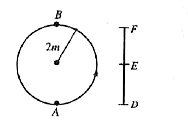A source of sound emitting a frequency 660 Hz is moving counter-clockwise in a circular path of radius 2 metres with an angular velocity 15 rad/s. A recorder at a distance from the source is moving simple harmonically along a straight line with an amplitude 2 metres. The frequency of SHM is 152π per second. The arrangement is shown in figure. When the source is at point A the detector is at D. Find the maxium and minimum frequencies recorded. Velocity of sound in air at this temperature can be taken as 300 m/s

870 Hz, 480 Hz
733.4 Hz, 600 Hz
680 Hz, 380 Hz
580 Hz, 280 Hz
The correct Answer is:B
Similar Questions
A source of sound is moving along a circular orbit of radius 3meter with an angular velocity of 10rad/s. A sound detector located far away from the source is executing linear simple harmonic motion along the line BD with an amplitude BC=CD=6meters. The frequency of oscillation of the detector is 5π per second. The source is at the point A when the detector is at the point B. If the source emits a continuous sound wave of frequency 340Hz, Find the maximum and the minimum frequencies recorded by the detector.

View SolutionA source of sound is moving along a circular orbit of radius 3meter with an angular velocity of 10rad/s. A sound detector located far away from the source is executing linear simple harmonic motion along the line BD with an amplitude BC=CD=6meters. the frequency of oscillation of the detector is 5π per second. the source is at the point A when the detector is at the point B. if the source emits a continous sound wave of frequency 340Hz, find the maximum and the mnimum frequencies recorded by the detector.

View SolutionA source of sound is moving along a circular orbit of radius 3 m with an angular velocity of 10 rad/s. A sound detector located far away from the source is executing linear S.H.M. along the line BD (see Fig. 14.4.13) with an amplitude BC = CD=6m. The frequency of oscillation of the detector is 5/π per second. The source is at the point BA when the detector is at the point B. If the source epiits a continuous sound wave of frequency 340 Hz, find the maximum and the minimum frequencies recorded by the detector.

View SolutionA source of sound emitting a note of frequency 200 Hz moves towards an observer with a velocity v equal to the velocity of sound. If the observer also moves away from the source with the same velocity v, the apparent frequency heard by the observer is
View SolutionA source of sound emitting a note of frequency 200 Hz moves towards an observer with a velocity v equal to the velocity of sound. If the observer also moves away from the source with the same velocity v, the apparent frequency heard by the observer is
View SolutionA source of sound of frequency 500 Hz is moving towards an observer with velocity 30 m/s . The speed of sound is 330 m/s . the frequency heard by the observer will be
View SolutionA source of sound of frequency 500 Hz is moving towards an observer with velocity 30 m/s . The speed of sound is 330 m/s . the frequency heard by the observer will be
View SolutionA source of sound of frequency 256 Hz is rotating in a circle of radius 3 m with angular speed of 20 rad/s. A listener is standing at rest along the line of centre of the circle. Under which position of the source of sound the listener will hear sound of
(a) maximum frequency
(b) minimum frequency
(c) same frequency as the frequency of source.
View SolutionA sound source is moving on a circular path of radius R with constant angular speed ω in anticlockwise direction and emits a frequency n.
An observer performs simple harmonic along the path QPR with time period T = 2πω as shown in the figure. If at t = 0 source is at A and observer is at Q and assume OP is very large as compare to radius R and QP, then -

View SolutionA sound source is moving on a circular path of radius R with constant angular speed ω in anticlockwise direction and emits a frequency n.
An observer performs simple harmonic along the path QPR with time period T = 2πω as shown in the figure. If at t = 0 source is at A and observer is at Q and assume OP is very large as compare to radius R and QP, then -

View Solution
